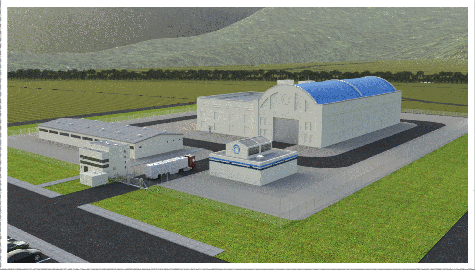 The US Nuclear Regulatory Commission has completed its final environmental impact statement (FEIS) on Kairos Power’s application for a permit to build a test version of the company’s Hermes advanced reactor design in Oak Ridge, Tennessee. NRC staff recommended that the permit should be issued. The staff will submit the FEIS and the final safety evaluation report (FSER), which was completed in June, to the Commission for the mandatory hearing phase of the licensing process. Following the hearing, expected to take place later this year, the Commission will vote whether to authorise the staff to issue the permit.
The US Nuclear Regulatory Commission has completed its final environmental impact statement (FEIS) on Kairos Power’s application for a permit to build a test version of the company’s Hermes advanced reactor design in Oak Ridge, Tennessee. NRC staff recommended that the permit should be issued. The staff will submit the FEIS and the final safety evaluation report (FSER), which was completed in June, to the Commission for the mandatory hearing phase of the licensing process. Following the hearing, expected to take place later this year, the Commission will vote whether to authorise the staff to issue the permit.
Kairos filed the application in September 2021, seeking a permit to build a 35 MWt reactor that would use molten salt to cool the reactor core. The test reactor, which will not generate electricity, is intended to provide operational data to support the development of a larger version for commercial power production. Kairos Power will have to submit a separate application for an operating licence and obtain approval from the NRC before operating the Hermes reactor.
"This is the final document from NRC staff to support the commission hearing planned later this year and marks the formal conclusion of the environmental review for the Hermes construction permit application," Kairos noted.
Darrell Gardner, senior licensing director at Kairos said the FEIS is the result of extensive engagement between Kairos Power and NRC since 2018. "It builds upon selecting and characterising an appropriate site for Hermes, engaging with the local community, and continuously communicating with stakeholders,” he said.
In July, Kairos submitted an application to NRC for permission to build the Hermes 2 plant next to the Hermes reactor at Oak Ridge. Hermes 2 comprises two 35 MWt reactors, each the same size as the original test reactor, that share a power generation system. NRC is now assessing the application to determine if it is acceptable and complete enough to begin the formal technical review process.
Hermes 2 is a non-power stepping stone towards deployment of the Kairos Power FHR (KP-FHR). This is an advanced reactor technology that uses TRISO (TRI-structural ISOtropic) fuel in pebble form combined with a low-pressure fluoride salt coolant. The technology employs a steam cycle to convert heat from fission into electricity and to complement renewable energy sources. The purpose of Hermes 2 is to further reduce risk on the path to commercialising the KP-FHR technology, demonstrating licensing, construction, operations, training, and decommissioning of a multi-reactor plant to help estimate the cost of the first commercial unit.
The 35 MWt Hermes demonstration reactor design was awarded $629m in cost-shared risk reduction funding over seven years by the US Department of Energy under the Advanced Reactor Demonstration Program. It aims to provide operational data to support development of the larger version for commercial deployment.
A site has been selected for the demonstration reactor at the East Tennessee Technology Park in Oak Ridge, and TRISO fuel pebbles will be produced at the Los Alamos National Laboratory's Low Enriched Fuel Fabrication Facility under an agreement reached in late 2022. The company has also commissioned a plant in partnership with Materion Corporation to produce high-purity fluoride salt coolant – known as Flibe – a eutectic mixture of lithium fluoride and beryllium fluoride.
The earliest possible start date for construction of Hermes 2 is put at July 2025 with the aim of completing the first unit between July 2027 and December 2027. Construction of the second unit is expected to be completed one year after the first unit. The reactors will have a short operating period of 11 years. Kairos CEO Mike Laufer acknowledges that this is an ambitious plan but believes it is achievable.
Image: Rendering of the Hermes demonstration plant at Oak Ridge (courtesy of Kairos Power)



